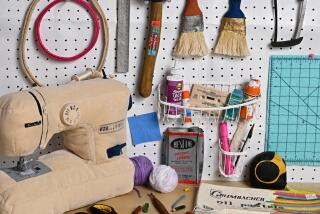Owner Reworks Base of Woodcraft Firm
When Joanne Wald, 55, got the opportunity to purchase a wholesale woodcraft business 18 months ago, it seemed like a dream come true: Her youngest child had just left for college, she had a lifelong love of art and her previous entrepreneurial success afforded her the means to pursue a new endeavor. But Wald said she quickly realized that if she was going to keep the doors open, she had to shift her focus from the sublime to the pragmatic. She said overhauling the production line and increasing manufacturing efficiency, along with rekindling relationships with clients, were her top priorities. Wald was interviewed by freelance writer Karen E. Klein.
*
My intention when I purchased this business was to realize my dream as an artist and to design something beautiful that would be sold to a wide audience. It took blind courage to get into something so dramatically different after I had been a commercial property investor and manager, especially since I knew nothing about manufacturing and there are very few women in this field.
Because our handmade, intricate wooden jewelry boxes are so beautiful, I could have easily stayed focused on the romance of the art and the design, materials and crafting. But I realized that if the artisan aspect of the business stayed my top priority, we would fail. As I became enmeshed in the business, my role as an artist had to diminish so I could be focused on the reality of making enough money to open the doors every day.
With 20 skilled artists working on each piece, my fixed labor costs are 50% of my expenses. We use high-quality, exotic wood and our lumber bills are huge. For us to be successful and sell our products at competitive prices, our operation has to be incredibly efficient.
My first lesson was in streamlining production. I made a mistake in not following my intuition about the person who was running my operations and production. I felt that he didn’t have the proper knowledge for the job, but I was timid about acknowledging that because of my own lack of experience, and my reluctance set me back half a year. We had plenty of orders, but we weren’t able to fill them because of a production bottleneck that meant we could never catch up with order volume.
I finally realized that I could not be afraid of any aspect of my business. I just had to plunge in. I hired a wonderful employee with 20 years’ experience in the lumber business, and he helped me gear up production. We started by getting feedback from the employees who have been here for years. I was a little apprehensive because I was the first female in the company’s history, but my relationship with the employees has worked out nicely.
I made the decision that we could not justify producing the less popular and very small pieces that were incredibly labor-intensive and did not bring in acceptable margins. A year ago, we had 75 products in our catalog; now we make 35. The designs that we update two or three times a year are driven by material availability and pricing, as well as consumer tastes, which tend to be conservative in this market.
Next, I looked over our production area to see why we couldn’t keep up with demand. Our space is limited to 5,000 square feet, and much of that is taken up by the large equipment that turns raw lumber into intricate handcrafts. Two pivotal employees helped me see that the cutting and gluing and assembly we do in the back shop moved much faster than the fine finishing going on upfront. We had piles and piles of boxes done and ready to be finished, but not enough space and people to complete them.
I started asking around and got one employee’s wife interested here and another one there. These women already worked with their hands in an artistic way and had sewing experience. The guys were resistant at first, but they trained a couple of women and saw how well they were working out, plus they were happy that their wives were getting work. I made the finishing area larger and brought in four more women.
Although we had no lack of orders, I realized that the former owners had neglected their clients. They had become involved in another successful business four years earlier and left this company to run itself.
Their customers barely got phone calls or mail, yet they still ordered like crazy because they were devoted to this product. It only took me focusing on digging up old records and getting back in touch with all our clients to double our sales. Going to arts and crafts shows four to six times a year has also helped. Now, we have 750 art and crafts galleries around the U.S. that buy our products and several clients in Europe. Locally, our pieces are sold at Del Mano Gallery, People’s Pottery and Fred Segal.
*
If your business can provide a lesson to other entrepreneurs, contact Karen E. Klein at the Los Angeles Times, 1333 S. Mayflower Ave., Suite 100, Monrovia, CA 91016, or at kklein6349@aol.com. Include your name, address and telephone number.
At a Glance
Company: Wood of a Kind
Owner: Joanne Wald
Nature of business: Manufactures handcrafted wooden boxes
Location: 4525 W. Jefferson Blvd., Los Angeles, CA 90016
Founded: 1979
E-mail: woodofakind@aol.com
Web site: www.planetshoppers.com/woodofakind
Employees: 22
Annual revenue: $1 million
More to Read
Inside the business of entertainment
The Wide Shot brings you news, analysis and insights on everything from streaming wars to production — and what it all means for the future.
You may occasionally receive promotional content from the Los Angeles Times.










